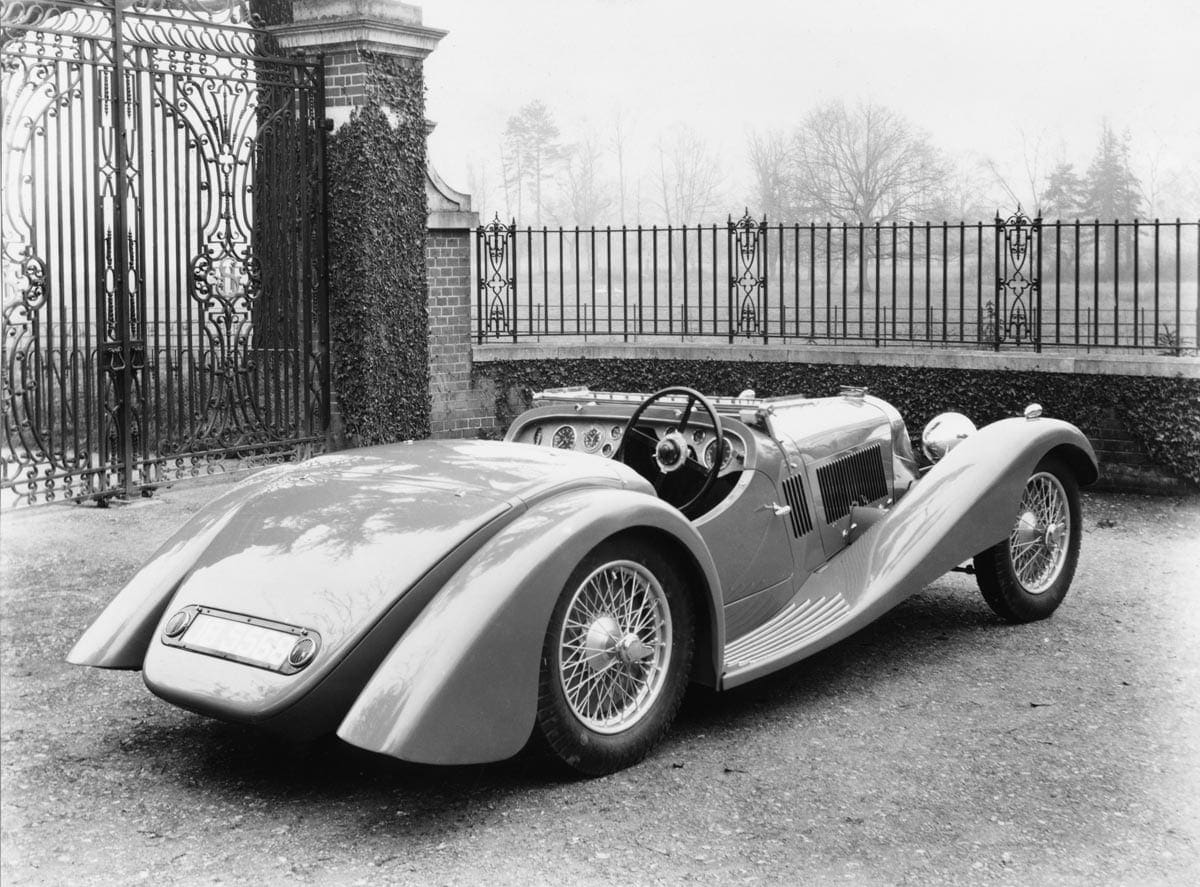Squire built these cars to such a high standard, and at such great cost, which unfortunately put the company out of business. He built only 7 of these beautiful automobiles.
THESE CARS
As a young man, Adrian Squire dreamed of making the perfect sports car. Having inherited about $150,000, in 1932 he used his engineering experience at the MG car firm to establish a small manufacturing company in a garage near Remenham Hill, Henley on the Thames in England. After less than five years, his company went out of business, but during that time he made seven remarkable cars, three with a two-passenger sports body designed by van den Plas to his specifications.
Powered by a British Anzani four cylinder, double overhead cam supercharged engine (the supercharger was rumored to have been built by David Brown and sons), the resultant near 1,500 ccs produced 130 horsepower at 5,000 RPM with two large SU carburetors delivering fuel through a beautifully finned aluminum inlet pipe with spring loaded pop-offs valves. Fuel economy was as high as 24 miles per gallon.
A four speed Wilson–ENV preselector gearbox made driving a pleasure though on-the-road training was required. Another interesting feature was the automatic central lubrication of the chassis from a reservoir on the firewall. A dynamotor, run directly from the crankshaft which, after the engine starts, swaps polarity and becomes a generator. Gigantic light alloy brake drums with chrome steel liners were strong enough to break the chassis on a panic stop.
The car was a masterpiece of beautiful design complimented by technical advances which made it unparalleled in its day. In a road test, Phil Hill favorably compares this car to a 2.3 Alfa and Type 55 Bugatti.
Finding no market, he left the company in 1936 and went to work with his hero, WO Bentley, at the Bristol Aeroplane Company where he died during a German air raid. The remains of the Squire Company was taken over by Val Zethrin. He attempted to change the design and to find funding to start up production again, but this failed and the whole thing kind of dribbled away after many years.
OUR CAR
There are two Van Den Plas body short chassis versions of the Squire left, ours, the prototype, and another they discovered which had little left of an engine in Texas and purchased at auction. A masterful restoration and recreation of an engine resulted in a resurrection of an equally beautiful example.
Enter Charles Davison, a sports car enthusiast from Birmingham, Michigan. He answered a 1951 advertisement in The Motor magazine and finally could purchase this car from England. After a memorable drive from the dock in New York to his home in Michigan, he began a four-year restoration. It was during this time that the car had its most enthusiastic ownership. Davison’s family still comes to visit the car accompanied by pictures which reveal how important the Squire was as not only as a beautiful sports car but as a source of family enjoyment.
Subsequently, the car sold to Charles H. McManus and then to Edward Sandgren whose passion for the car evolved from its image in the September 1955 Road and Track Salon. Restorer Charles Stitch refreshed the engine, and they drove it for some time before being purchased by the Harrah Automobile Collection and subsequently put in storage. Harrah did little with the car, apparently having it on schedule for his restoration team to put it right. After Harrah’s death, the car somehow found its way into venture capital financier Tom Perkins’ collection who had Phil Reilly do his usual magnificent restoration.
We found the car to be in good condition but required re-commissioning to make it ideal for the road and for the standards Perkins required. We put the original color, a robin’s egg blue back. All of our data shows that this was, in fact, the first paint hue. A magnificent example, when completed the over shiny restoration did not overshadow the beautiful lines. Perkins would show it and recieve much fanfare at Pebble Beach and other
I always lusted for this car and when I learned that Tom Perkins was divesting his collection, he and I conversed, and the car was mine. During this conversation I asked him why he was selling his collection and he said that he always wanted to live on a boat. “If you want Greek food, why not dine in Greece?” He did, in fact, build the largest sailing boat of its kind ever, complete with every amenity including a computer room, swimming pool, massive sails which fold into their masts, a panoply of original and unusual designs. If you want to read about this boat, the Maltese Falcon, the book Mine’s Bigger by Richard Kaplan is enjoyable.

I didn’t realize it at the time, but back in junior-high study
Adrian Squirehall I was sketching the Squire.
















